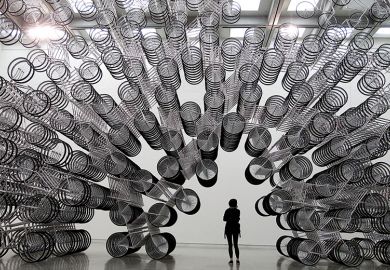Colourful portrayals of the masters in any discipline can be as alienating as they are inspiring to a young scholar trying to find his or her niche. This is particularly so in mathematics, where triumphs come not just from hard work and brilliance but also luck, and whose luminaries are typically portrayed as insular, obsessive and, to be kind, eccentric.
In their compilation of articles by and about women mathematicians, Bettye Anne Case and Anne Leggett offer a refreshing alternative to the usual biographical sketches of mathematicians. On the surface, Complexities appears to be doing too much, presenting anecdotes, biographies, accounts of women's organisations and conferences, historical data on women's presence in academia, alternative career paths for mathematicians, the dual biases confronting minority women and some of the scientific contributions of great female mathematicians, all written in different voices and often intended for different audiences. Remarkably, this ambitious melange succeeds in providing a nonlinear immersion into the real lives, experiences, and passions of mathematicians working in today's world. Although Complexities reads like a compilation - and one whose authors are professionally trained to write in the third person, peppered with Greek letters - even the less polished accounts give the book a unique, honest appeal.
From a historical perspective, Complexities is most fascinating in its first section, portraying the transition made by women in mathematics over time. Despite the prejudices that remain, we can appreciate how far we have come from the late 1700s when Sophie Germaine was secretly studying by contraband candles to avoid her family's condemnation of women doing mathematics. Or from Sonia Kovalevsky's sham marriage in the 1860s to escape parents who refused to send her to university, only to find that women were barred from matriculating (despite the word's etymology). Or from Charlotte Scott's impressively high placement in the mathematics exams at the University of Cambridge in 1880, but who was nonetheless denied official recognition.
The remaining sections contain gems that will inspire young women in mathematics, offering a plethora of advice to help them navigate their careers and lives. There is no doubt that a female mathematician will respond to more aspects of this book than a man or a non-mathematician. She will share many of the experiences, passions and frustrations expressed by her female colleagues, who most likely include friends and role models. She will benefit from useful insights, will discover the importance of mentoring other young women and might be inspired to join the Association of Women Mathematicians. Most important, she will be reminded that she is part of a diverse community of caring, thoughtful, brilliant women.
Yet, Complexities could be equally rewarding for anyone interested in understanding the complicated choices and experiences of any academic, regardless of gender, or the obstacles facing women in any male-dominated profession.
Maria Klawe shares her experiences of switching mathematical fields when encountering a dismal job market, reinventing herself as a computer scientist at a time when this field opened the door to many more opportunities. Susan Landau and Margaret Murray discuss personal choices and sacrifices, the former with regard to family and the latter with regard to geographical preference. Karen Uhlenbeck talks with joy about the courage to venture into new areas, discovering surprising interconnections between disparate areas of mathematics and the sciences. The sister of renowned mathematician Julia Robinson conveys the outsider's perspective on a brilliant sister juggling family life, mathematics and political activism.
Academics from all areas, as well as professionals in demographically narrow fields, will be reminded that their disciplines are enriched when bias is kept in check and a broader spectrum of participants than the "usual suspects'' invited to high-profile conferences and events.
On the downside, because many articles were originally written for other publications, the book lacks coherence. The scores of articles are loosely organised into five sections, varying in importance and rationale. The fourth section recounts talks from a conference in honour of mathematician Olga Taussky-Todd celebrating women's careers in mathematics. While this section offers useful advice on alternative career paths, many of the articles reflect on Taussky-Todd's life and work, so it collectively reads like a separate book.
Other sections occasionally share a similar unevenness of focus and voice.
This is somewhat mitigated by the editors' commentary prefacing each section, which facilitates tailoring the book to one's particular interests. Readers from non-technical professions, for instance, can easily skim articles heavy with mathematics, perhaps only gleaning the enthusiasm of their authors.
In reaching out to a diverse audience, the editors avoid the temptation of focusing exclusively on the greatest female mathematicians of all time, although many of them are, in fact, profiled. Instead, they depict today's female mathematicians as scientific everywomen - some self-proclaimed "less than spectacular", others at the top of their fields - balancing both the struggles and jubilations of everyday academic life.
While this frank portrayal will inspire many, it is possible that some may misconstrue the book's message in light of Harvard president Lawrence Summers's recent comments postulating innate differences between men and women in the hard sciences. In fact, through its multifold agenda, the book amply demonstrates the acuity of the female mathematical mind, consistently thriving despite omnipresent societal obstacles.
Editors Case and Leggett must be commended for tackling the complexities of their subject matter, and serving a diverse audience by archiving such a wide spectrum of material. Even casual readers may be rewarded if they listen to the collective voice of a significant, although sometimes overlooked, population that has made great contributions to the modern world of mathematics.
Dana Randall is associate professor of computer science, Georgia Institute of Technology, US.
Complexities: Women in Mathematics
Editor - Bettye Anne Case and Anne M. Leggett
Publisher - Princeton University Press
Pages - 412
Price - £22.95
ISBN - 0 691 11462 5



